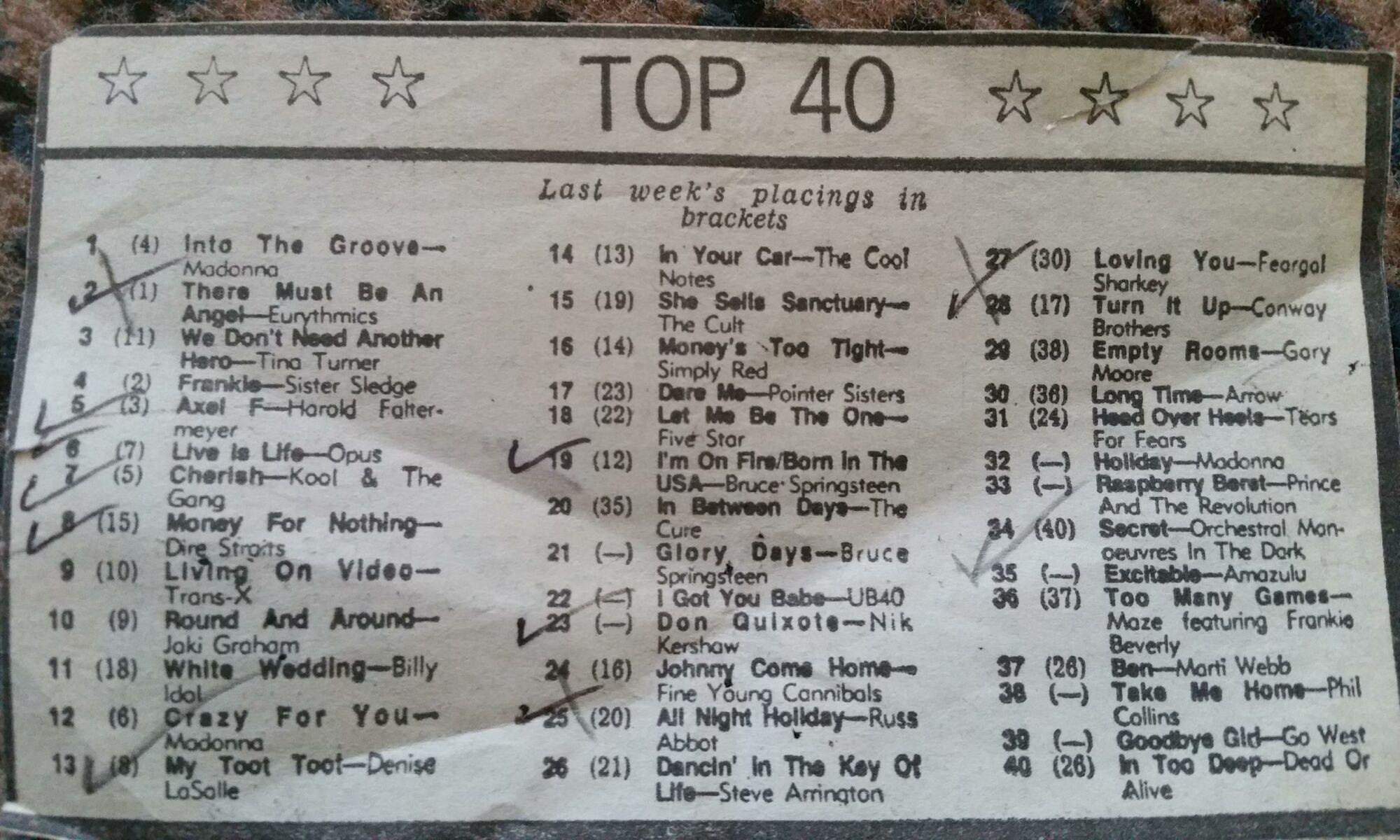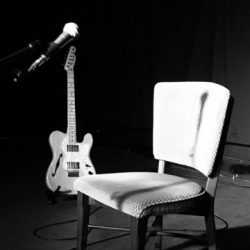I started attending secondary school in 1987. It was a time of bad hair, NHS glasses and a general feeling of dread regarding the notorious antics of big boys at the big school. Tales of blue goldfish (untrue), peanut ties (very true) and sado-fascist games teachers (horrifyingly true) dominated conversation among my little group of friends. We were tiny little people entering an ocean of cruelty and really just wanted to emerge five years later with some shred of dignity intact. A lad who lived down the road from me was already at the school and about to enter his fourth year. His advice was to fit in no matter what. Find out what’s cool and go with that. Whatever music people are listening to, whatever way ties and blazers are being worn (it was the era of the little thin bit of tie being the only bit on show with the fat bit hidden away – very stylish), whatever the insult-du-jour is – just go with it. I know now that this type of conformity leads to no good and, when I was a bigger boy (never a real big boy), I grew my hair long and used Ned’s Atomic Dustbin and Shoegaze as markers of my contrariness. But then, for a terrified and podgy eleven year-old with rubbish eyes, fitting in seemed like it was good advice. I just never knew this would mean nicking car badges.
Beastie Boys mania actually started out as Run DMC mania. We were absolutely not allowed to wear trainers to school but the serious rebels did. Of course, trainers (I would claim that they were Adidas shell toes but, let’s be honest, there were mostly those awful fat Hi-Techs) look rubbish with smart trousers and teenage boys, with their weird, massive feet, look even more rubbish. But, the hard kids, the Embassy number 1 kids and the don’t-give-a-fuck kids wore trainers. One day, the laces were gone. A lad in my class with an older brother (always a conduit to the ever shifting rules of cool) told us that this was because Run DMC didn’t wear laces. They were too cool for laces. Laces were now uncool. Did this mean that I could wear slip-ons like my Dad’s friends? Sadly not.
To be honest, I wasn’t really sure what Run DMC were (was?). I knew they were music. I had seen them on Top of the Pops on the video with people yelling at each other through a wall, some of whom were long haired and angry, some of whom were in tracksuits and shoes with no laces and looked a little more in control. This, apparently, was rap. No-one was calling it hip-hop then. The lad with the older brother had a tape called ‘Rap Attack’ (yes, he was really fucking annoying – like that kid on Johnny Briggs who always started their sentences with, ‘my mother, who’s a nurse’ but saying instead, ‘my brother, who’s a fourth year’) which we all had a listen to on our orange spongey earphones. It had what I now know are some stone cold classics and some utter dross. Not bad though. ‘Got anything else like this?’ I asked him. He shoved a blank C90 with ‘lissince to ill’ (sic) scratched on it in blue biro and said, ‘my brother says this is the best rap you can get’. It was very shouty and had loud guitars. I liked it. No real need to pretend.
And so, along with the rest of my school, I got into the Beastie Boys. Ad-Rock, MCA and Mike D acted like brats and shouted about cigarettes and porno mags. It was the height of sophistication. They wore cool clothes and seemed to be saying that rebellion was not only possible but also some sort of moral imperative.
Key to their look and their world of naughtiness were the VW badges they wore on the end of long chains. What sartorial genius was this? Way better than the no laces thing. We had to have a go and so began my brief flirtation with petty theft. We would hide in hedges and act lookout for each other as we wrenched badges away from their metallic homes. It was a thrill but also shit scary. I was not in any way a bad lad. I didn’t even try smoking until I was 15. But this seemed like just the type of fitting in I had been advised to do.
The problem was that our school sat in amongst some seriously leafy middle class streets and, once we had run out of VW badges to pinch, we just went for anything. Ford, Merc, BMW, Renault. If it had a badge we would nick it. Soon, the badges were rivalling Panini stickers, Garbage Pail Kids and small bits of hash as swapsies. The school went into meltdown. Locker searches, a surprise visit from the head and a local copper to each class, letters home. Parents were exchanging outrage over garden fences and between car windows. This was a crime pandemic and ‘those fucking bestie brothers are to blame’! No more rap music! Down with rap music! God it was awesome. It turned out that fitting with the big boys was a lot of fun.

I’ve been revisiting this a lot over the last two weeks while I’ve been reading the Beastie Boys Book. The adult me always suspected that these marvellous mavericks were a carefully constructed package and that the teenage me had been sold a doozie of a product. The book partially confirms this and the brash sexism of Licence to Ill certainly turns out to be little more than an ironic swipe (but one that has not aged well at all) at MTV culture (although I love the fact the infamous hydraulic phallus gets a Christmas airing from the storage unit staff every year – tinsel that!) and the birth of their own celebrity. But, the book also sort of authenticates that they really were bratty and stupid. They went through the same sets of in-jokes that all of your friends did and could be as wonderfully kind or arbitrarily unpleasant as the rest of us.
This book, if I were inclined to do such a thing (and I am) could be categorised as a ‘mixtape memoir’. It is a polyphonic bricolage of voices, photography and artwork that jumble, tumble and clash. Ad-Rock will tell a story and Mike D will intervene and say, ‘that’s not quite what happened…’. The opposite will happen elsewhere. There are interventions from, among others Colson Whitehead, DJ Anita Sarko, Spike Jonze and Wes Anderson. The stories are weird, funny and banal. They are a checklist of alternative cool and New York kitsch. Butthole Surfers, Lee Scratch Perry, Bad Brains and Dolly Parton rub shoulders with 808 drum machines, cookie puss ice cream cake (it does sound amazing) and a litany of sugary treats and nasty booze from sketchy bodegas.
The book is a visual adventure. New York is what you would expect and what you would never imagine. Brooklyn pizza parlours, scuzzy clubs and beat up blocks but also hidden studios, old wooden buildings and fancy pants middle class art schools. The band themselves are hyper active. Never sitting still, faces perpetually pulled into sarcastic scowls. You can hear those glorious nasal whines tripping and spitting off every page. There is so much going on that you get a kind of literary ice-cream headache from it all. Your eyes ache and you know you need to call it a night but you want to explore one more photo and enjoy one more anecdote ending up in a crazy getaway or a weak-ass PA system blowing up.
Reading this book is a tactile sensation. One of the early chapters sees Ad-Rock take us through the mechanics of making and carrying mixtapes themselves. Titled ‘Well, Back In My Day’, it is both nostalgic and a giant piss-take of nostalgia. It seems to say that, yes, mixtapes were a labour of love and an important part of young cultural and social capital building but, also, that they were a pain to carry around and you spent half your life taping them back together and finding a pen to wind the tape back after an inevitable jam up in your cheapo cassette player. The book itself is a whopper. It weighs far too much to carry around and read on the bus. This is a good thing. It means selecting your Beastie Boys LP of choice and getting comfy for a good session with it. You read great big chunks hungrily (breaking only to write blog posts of dubious quality) and ache for your youth.
All of the fun is, of course, undercut by the grief and melancholy that all involved feel for the awful loss of their friend and trouble-making partner MCA. His voice is a tangible absence. He is the centre of the world and haunts every page of this text. This is what elevates the book from being an exercise in merely celebrating the glories of youthful stupidity or the simplicity of the pre-digital era. It is an elegy and a tribute. It is a trauma text built around the unmoving solidity of friendship. Long live MCA.
After my young teenage flirtation with rap and petty crime, I sort of lost touch with the Beastie Boys. A certain Top of the Pops episode featuring certain naughty looking Mancs (and Kirsty MacColl) set me off down a path to indie obsessions, DIY pretensions and involvement in terrible bands with terrible names. It was only when I was about 17 and now worldly wise (well, I liked Aphex Twin and the Velvet Underground) that my friend played me Ill Communication. I couldn’t believe this was the same band. Yes, the nasal tones and humour were still there but the layers of sampling and lyrical complexity were now so sophisticated. He told me to watch the ‘Sabotage’ video and, to this day, I can’t think of a finer three minutes and two seconds. It really is genius.
Once I got to university, I was a fully fledged fan again. Indeed, the band were hugely popular. In my halls of residence, a call from home would be signalled with shouts of ‘the phone is ringing’ which in turn was met by shouts of ‘oh ma gawd’. I never told anyone there about the car badge theft pandemic. It seemed so stupid and childish. Funny now that in my 40s, stupid and childish is what I most long after. Even now, I find it hard to walk past a neighbour’s motor (any motor) without thinking about how cool the badge would look dangling around my neck. Please don’t tell my mum.

